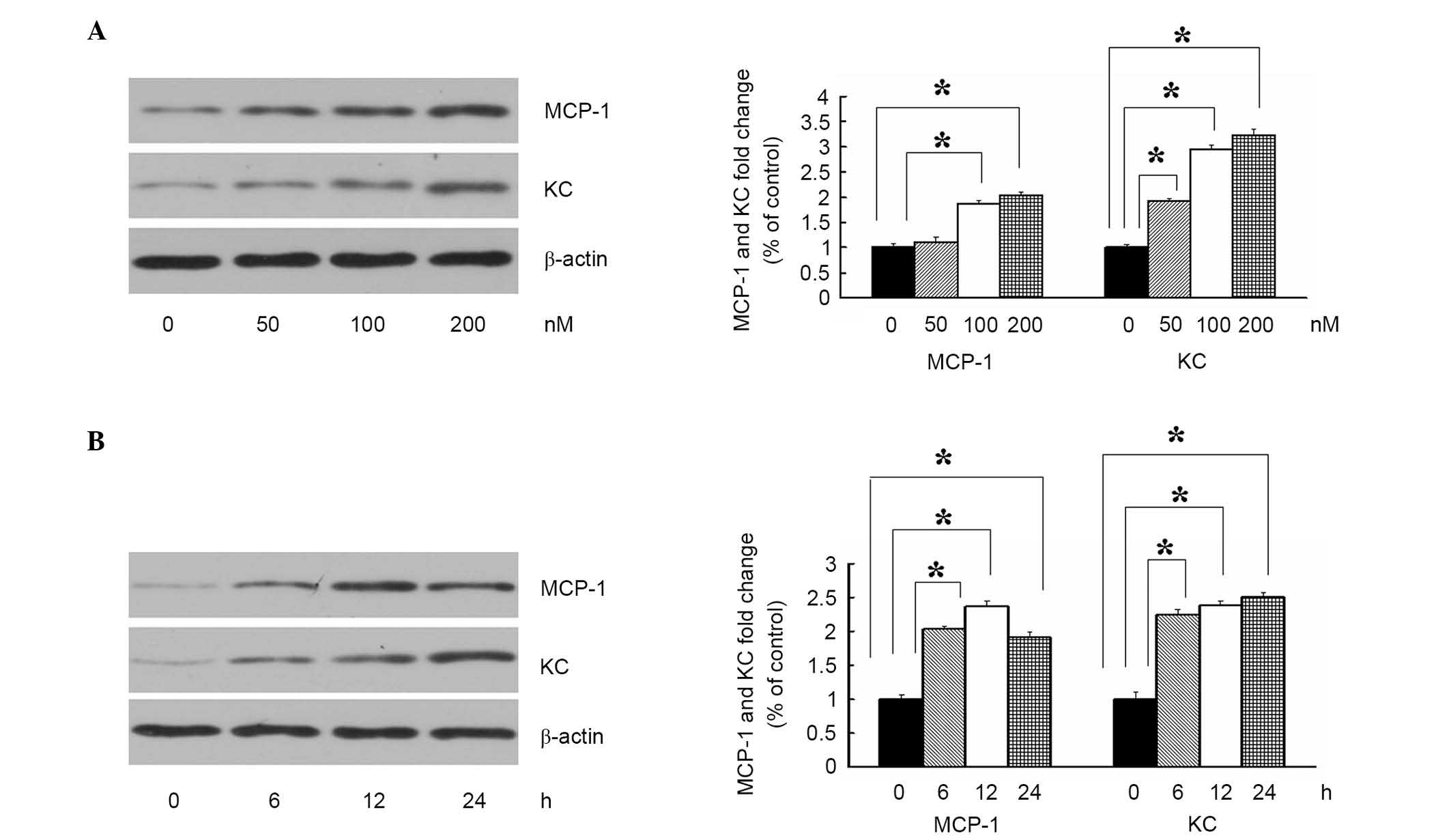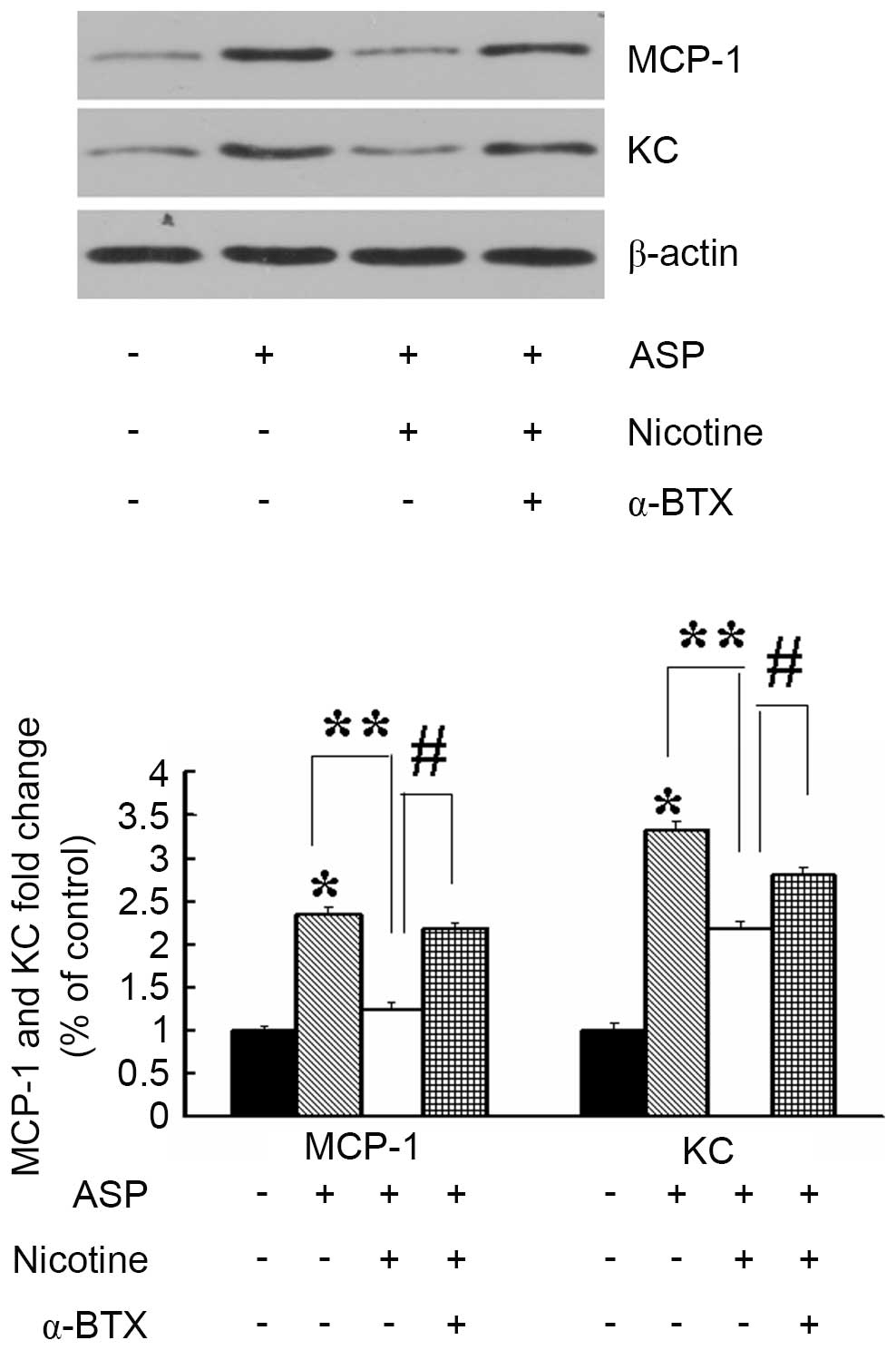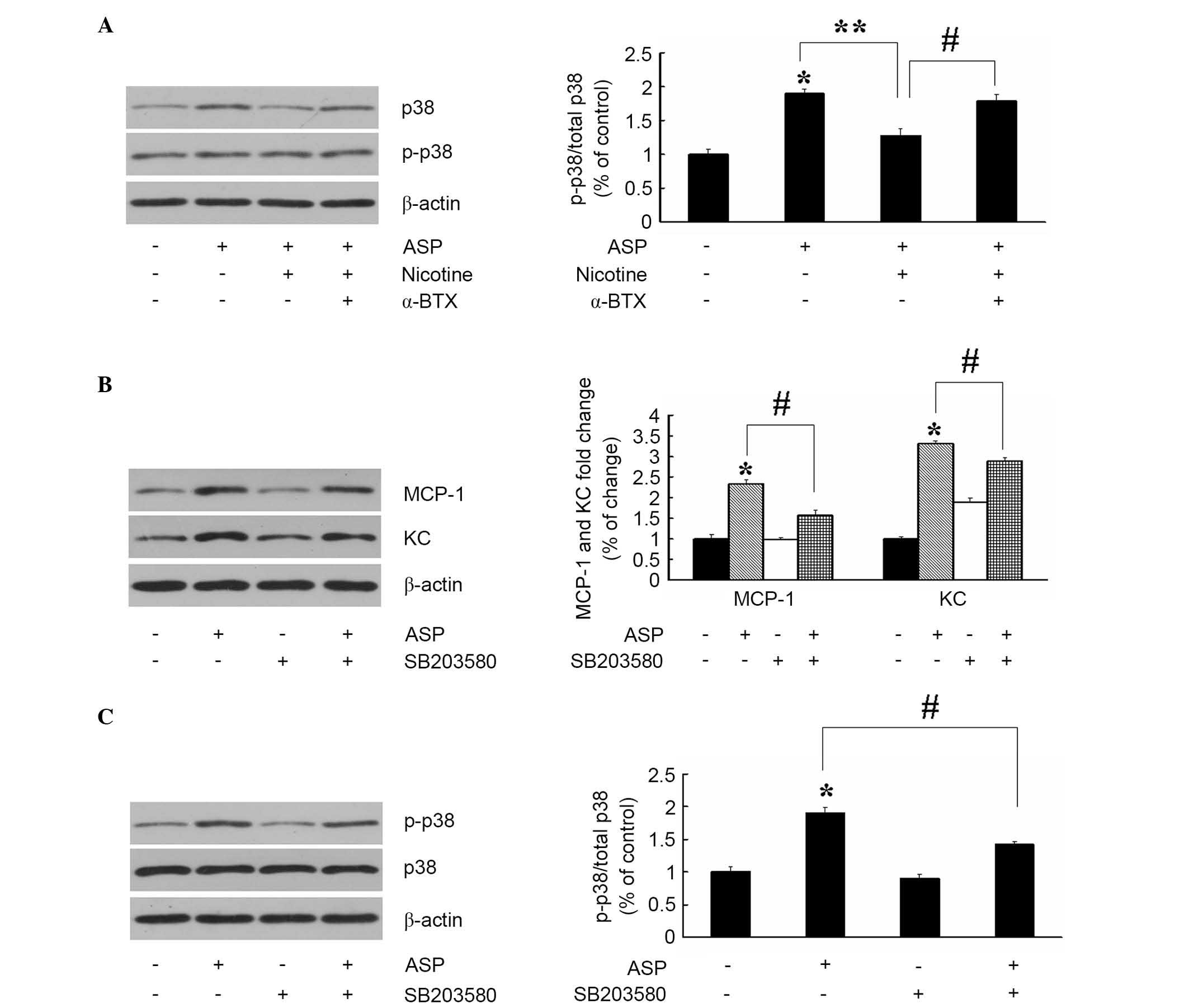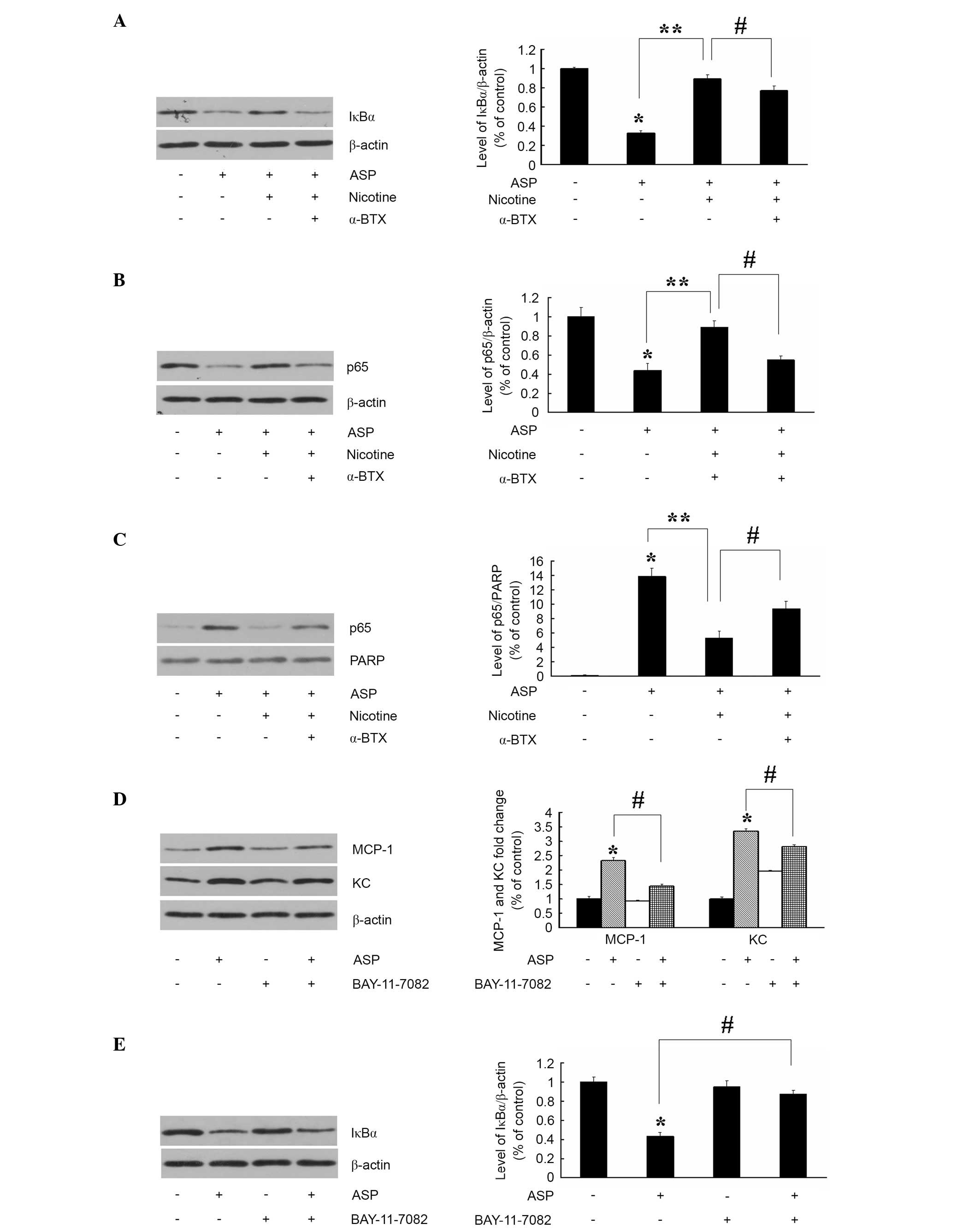|
1
|
Coenen KR, Gruen ML, Chait A and Hasty AH:
Diet-induced increases in adiposity, but not plasma lipids, promote
macrophage infiltration into white adipose tissue. Diabetes.
56:564–573. 2007. View Article : Google Scholar : PubMed/NCBI
|
|
2
|
Neels JG, Badeanlou L, Hester KD and Samad
F: Keratinocyte-derived Chemokine in obesity: Expression,
regulation, and role in adipose macrophage infiltration and glucose
homeostasis. J Biol Chem. 284:20692–20698. 2009. View Article : Google Scholar : PubMed/NCBI
|
|
3
|
Tom FQ, Gauvreau D, Lapointe M, Lu H,
Poursharifi P, Luo XP and Cianflone K: Differential chemoattractant
response in adipocytes and macrophages to the action of acylation
stimulating protein. Eur J Cell Biol. 92:61–69. 2013. View Article : Google Scholar
|
|
4
|
van Maanen MA, Papke RL, Koopman FA,
Koepke J, Bevaart L, Clark R, Lamppu D, Elbaum D, LaRosa GJ, Tak PP
and Vervoordeldonk MJ: Two novel α7 nicotinic acetylcholine
receptor ligands: In vitro properties and their efficacy in
collagen-induced arthritis in mice. PLoS One. 10:e01162272015.
View Article : Google Scholar
|
|
5
|
Peña G, Cai B, Liu J, van der Zanden EP,
Deitch EA, de Jonge WJ and Ulloa L: Unphosphorylated STAT3
modulates alpha7 nicotinic receptor signaling and cytokine
production in sepsis. Eur J Immunol. 40:2580–2589. 2010. View Article : Google Scholar
|
|
6
|
Kim TH, Kim SJ and Lee SM: Stimulation of
the α7 nicotinic acetylcholine receptor protects against sepsis by
inhibiting Toll-like receptor via phosphoinositide 3-kinase
activation. J Infect Dis. 209:1668–1677. 2014. View Article : Google Scholar
|
|
7
|
Marrero MB, Lucas R, Salet C, Hauser TA,
Mazurov A, Lippiello PM and Bencherif M: An alpha7 nicotinic
acetylcholine receptor-selective agonist reduces weight gain and
metabolic changes in a mouse model of diabetes. J Pharmacol Exp
Ther. 332:173–180. 2010. View Article : Google Scholar
|
|
8
|
Cancello R, Zulian A, Maestrini S,
Mencarelli M, Della Barba A, Invitti C, Liuzzi A and Di Blasio AM:
The nicotinic acetylcholine receptor α7 in subcutaneous mature
adipocytes: Downregulation in human obesity and modulation by
diet-induced weight loss. Int J Obes (Lond). 36:1552–1557. 2012.
View Article : Google Scholar
|
|
9
|
Berg AH, Lin Y, Lisanti MP and Scherer PE:
Adipocyte differentiation induces dynamic changes in NF-kappaB
expression and activity. Am J Physiol Endocrinol Metab.
287:E1178–E1188. 2004. View Article : Google Scholar : PubMed/NCBI
|
|
10
|
Aggarwal BB: Targeting
inflammation-induced obesity and metabolic diseases by curcumin and
other nutraceuticals. Annu Rev Nutr. 30:173–199. 2010. View Article : Google Scholar : PubMed/NCBI
|
|
11
|
Dandona P: Insulin resistance and
endothelial dysfunction in atherosclerosis: Implications and
interventions. Diabetes Technol Ther. 4:809–815. 2002. View Article : Google Scholar
|
|
12
|
He Z, Zhu HH, Bauler TJ, Wang J, Ciaraldi
T, Alderson N, Li S, Raquil MA, Ji K, Wang S, et al: Nonreceptor
tyrosine phosphatase Shp2 promotes adipogenesis through inhibition
of p38 MAP kinase. Proc Natl Acad Sci USA. 110:E79–E88. 2013.
View Article : Google Scholar :
|
|
13
|
Roux PP and Blenis J: ERK and p38
MAPK-activated protein kinases: A family of protein kinases with
diverse biological functions. Microbiol Mol Biol Rev. 68:320–344.
2004. View Article : Google Scholar : PubMed/NCBI
|
|
14
|
Yoon SW, Goh SH, Chun JS, Cho EW, Lee MK,
Kim KL, Kim JJ, Kim CJ and Poo H: alpha-Melanocyte-stimulating
hormone inhibits lipopolysaccharide-induced tumor necrosis
factor-alpha production in leukocytes by modulating protein kinase
A, p38 kinase and nuclear factor kappa B signaling pathways. J Biol
Chem. 278:32914–32920. 2003. View Article : Google Scholar : PubMed/NCBI
|
|
15
|
Bowie AG and O'Neill LA: Vitamin C
inhibits NF-kappa B activation by TNF via the activation of p38
mitogen-activated protein kinase. J Immunol. 165:7180–7188. 2000.
View Article : Google Scholar : PubMed/NCBI
|
|
16
|
Feng M, Wang Y, Chen K, Bian Z, Jinfang Wu
and Gao Q: IL-17A promotes the migration and invasiveness of
cervical cancer cells by coordinately activating MMPs expression
via the p38/NF-κB signal pathway. PLoS One. 9:e1085022014.
View Article : Google Scholar
|
|
17
|
Saeed RW, Varma S, Peng-Nemeroff T, Sherry
B, Balakhaneh D, Huston J, Tracey KJ, Al-Abed Y and Metz CN:
Cholinergic stimulation blocks endothelial cell activation and
leukocyte recruitment during inflammation. J Exp Med.
201:1113–1123. 2005. View Article : Google Scholar : PubMed/NCBI
|
|
18
|
de Jonge WJ and Ulloa L: The alpha7
nicotinic acetylcholine receptor as a pharmacological target for
inflammation. Br J Pharmacol. 151:915–929. 2007. View Article : Google Scholar : PubMed/NCBI
|
|
19
|
Yoshikawa H, Kurokawa M, Ozaki N, Nara K,
Atou K, Takada E, Kamochi H and Suzuki N: Nicotine inhibits the
production of proinflammatory mediators in human monocytes by
suppression of I-kappaB phosphorylation and nuclear factor-kappaB
transcriptional activity through nicotinic acetylcholine receptor
alpha7. Clin Exp Immunol. 146:116–123. 2006. View Article : Google Scholar : PubMed/NCBI
|
|
20
|
Sun P, Zhou K, Wang S, Li P, Chen S, Lin
G, Zhao Y and Wang T: Involvement of MAPK/NF-κB signaling in the
activation of the cholinergic anti-inflammatory pathway in
experimental colitis by chronic vagus nerve stimulation. PLoS One.
8:e694242013. View Article : Google Scholar
|
|
21
|
Murray I, Parker RA, Kirchgessner TG, Tran
J, Zhang ZJ, Westerlund J and Cianflone K: Functional bioactive
recombinant acylation stimulating protein is distinct from C3a
anaphylatoxin. J Lipid Res. 38:2492–2501. 1997.
|
|
22
|
Shi D, Pop MS, Kulikov R, Love IM, Kung AL
and Grossman SR: CBP and p300 are cytoplasmic E4 polyubiquitin
ligases for p53. Proc Natl Acad Sci USA. 106:16275–16280. 2009.
View Article : Google Scholar : PubMed/NCBI
|
|
23
|
Takahashi K, Yamaguchi S, Shimoyama T,
Seki H, Miyokawa K, Katsuta H, Tanaka T, Yoshimoto K, Ohno H,
Nagamatsu S and Ishida H: JNK- and IkappaB-dependent pathways
regulate MCP-1 but not adiponectin release from artificially
hypertrophied 3T3-L1 adipocytes preloaded with palmitate in vitro.
Am J Physiol Endocrinol Metab. 294:E898–E909. 2008. View Article : Google Scholar : PubMed/NCBI
|
|
24
|
Martins RP, Kaur K, Hwang E, Ramirez RJ,
Willis BC, Filgueiras-Rama D, Ennis SR, Takemoto Y, Ponce-Balbuena
D, Zarzoso M, et al: Dominant frequency increase rate predicts
transition from paroxysmal to long-term persistent atrial
fibrillation. Circulation. 129:1472–1482. 2014. View Article : Google Scholar : PubMed/NCBI
|
|
25
|
Wang HF, Lin PP, Chen CH, Yeh YL, Huang
CC, Huang CY and Tsai CC: Effects of lactic acid bacteria on
cardiac apoptosis are mediated by activation of the
phosphatidylinositol-3 kinase/AKT survival-signalling pathway in
rats fed a high-fat diet. Int J Mol Med. 35:460–470. 2015.
|
|
26
|
Després JP: Body fat distribution and risk
of cardiovascular disease: An update. Circulation. 126:1301–1313.
2012. View Article : Google Scholar : PubMed/NCBI
|
|
27
|
Fisette A, Poursharifi P, Oikonomopoulou
K, Munkonda MN, Lapointe M and Cianflone K: Paradoxical
glucose-sensitizing yet proinflammatory effects of acute ASP
administration in mice. Mediators Inflamm. 2013:7132842013.
View Article : Google Scholar : PubMed/NCBI
|
|
28
|
Weber NC, Blumenthal SB, Hartung T,
Vollmar AM and Kiemer AK: ANP inhibits TNF-alpha-induced
endothelial MCP-1 expression-involvement of p38 MAPK and MKP-1. J
Leukoc Biol. 74:932–941. 2003. View Article : Google Scholar : PubMed/NCBI
|
|
29
|
Shytle RD, Mori T, Townsend K, Vendrame M,
Sun N, Zeng J, Ehrhart J, Silver AA, Sanberg PR and Tan J:
Cholinergic modulation of microglial activation by alpha 7
nicotinic receptors. J Neurochem. 89:337–343. 2004. View Article : Google Scholar : PubMed/NCBI
|
|
30
|
Suzuki T, Hide I, Matsubara A, Hama C,
Harada K, Miyano K, Andrä M, Matsubayashi H, Sakai N, Kohsaka S, et
al: Microglial alpha7 nicotinic acetylcholine receptors drive a
phospholipase C/IP3 pathway and modulate the cell activation toward
a neuroprotective role. J Neurosci Res. 83:1461–1470. 2006.
View Article : Google Scholar : PubMed/NCBI
|
|
31
|
Aicher A, Heeschen C, Mohaupt M, Cooke JP,
Zeiher AM and Dimmeler S: Nicotine strongly activates dendritic
cell-mediated adaptive immunity: Potential role for progression of
atherosclerotic lesions. Circulation. 107:604–611. 2003. View Article : Google Scholar : PubMed/NCBI
|
|
32
|
Zhang JZ, Liu Z, Liu J, Ren JX and Sun TS:
Mitochondrial DNA induces inflammation and increases TLR9/NF-κB
expression in lung tissue. Int J Mol Med. 33:817–824.
2014.PubMed/NCBI
|
|
33
|
Mishra NC, Rir-sima-ah J, Boyd RT, Singh
SP, Gundavarapu S, Langley RJ, Razani-Boroujerdi S and Sopori ML:
Nicotine inhibits Fc epsilon RI-induced cysteinyl leukotrienes and
cytokine production without affecting mast cell degranulation
through Alpha7/Alpha9/Alpha 10-nicotinic receptors. J Immunol.
2185:588–596. 2010. View Article : Google Scholar
|
|
34
|
Marrero MB and Bencherif M: Convergence of
alpha 7 nicotinic acetylcholine receptor-activated pathways for
anti-apoptosis and anti-inflammation: Central role for JAK2
activation of STAT3 and NF-kappaB. Brain Res. 1256:1–7. 2009.
View Article : Google Scholar
|
|
35
|
Chernyavsky AI, Arredondo J, Galitovskiy
V, Qian J and Grando SA: Upregulation of nuclear factor-kappaB
expression by SLURP-1 is mediated by alpha7-nicotinic acetylcholine
receptor and involves both ionic events and activation of protein
kinases. Am J Physiol Cell Physiol. 299:C903–C911. 2010. View Article : Google Scholar : PubMed/NCBI
|
|
36
|
Kox M, van Velzen JF, Pompe JC,
Hoedemaekers CW, van der Hoeven JG and Pickkers P: GTS-21 inhibits
pro-inflammatory cytokine release independent of the Toll-like
receptor stimulated via a transcriptional mechanism involving JAK2
activation. Biochem Pharmacol. 78:863–872. 2009. View Article : Google Scholar : PubMed/NCBI
|
|
37
|
Li X, Zhou X, Ye Y, Li Y, Li J, Privratsky
B, Wu E, Gao H, Huang C and Wu M: Lyn regulates inflammatory
responses in Klebsiella pneumoniae infection via the p38/NF-κB
pathway. Eur J Immunol. 44:763–773. 2014. View Article : Google Scholar
|


















